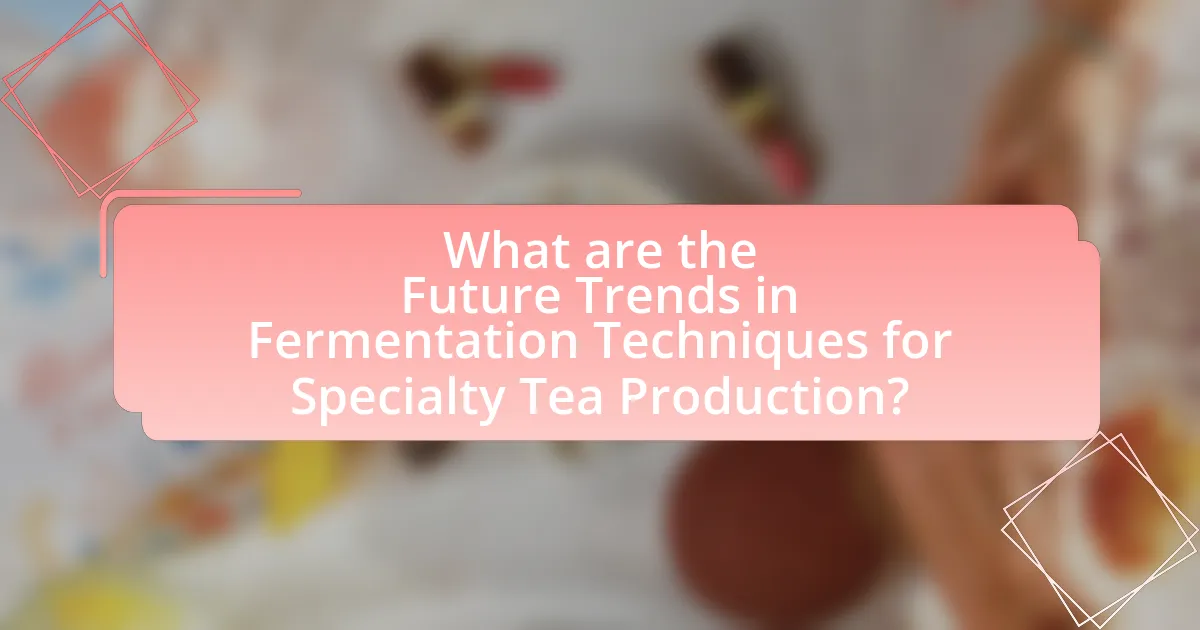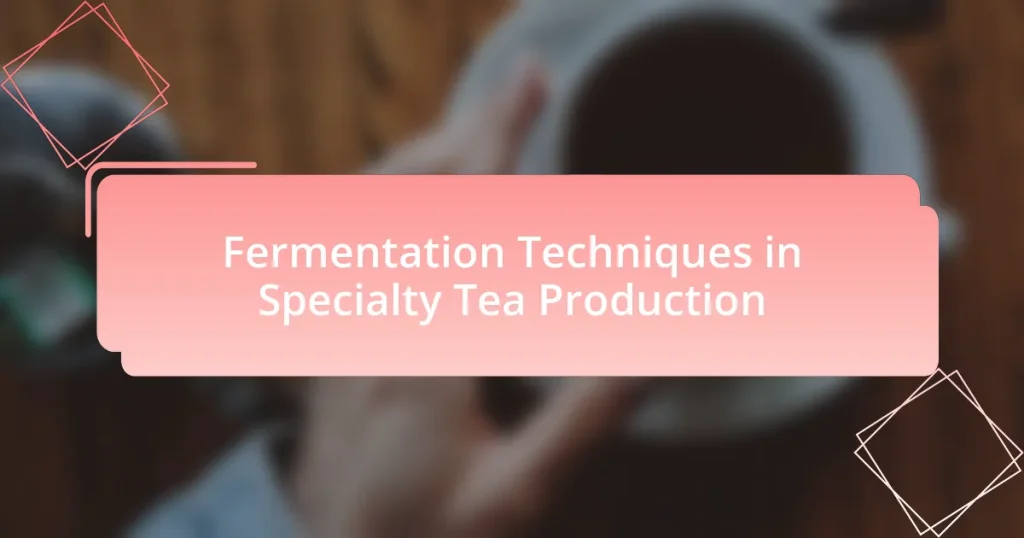Fermentation techniques in specialty tea production are essential processes that enhance the flavor, aroma, and color of tea leaves through controlled biochemical reactions. Key methods include oxidation and microbial fermentation, which significantly alter the chemical composition of the tea, impacting its sensory attributes and health benefits. The article explores how different fermentation durations and conditions affect taste and aroma, the chemical processes involved, and the importance of fermentation in distinguishing specialty teas from regular varieties. Additionally, it discusses the challenges faced during fermentation, future trends, and best practices for achieving consistent quality in specialty tea production.

What are Fermentation Techniques in Specialty Tea Production?
Fermentation techniques in specialty tea production involve controlled biochemical processes that enhance flavor, aroma, and color in tea leaves. These techniques include oxidation, where enzymes react with oxygen to develop complex flavors, and microbial fermentation, which utilizes specific bacteria and yeast to create unique profiles. For example, in the production of black tea, leaves are fully oxidized, resulting in a rich flavor, while in oolong tea, partial oxidation is employed to achieve a balance between green and black tea characteristics. The effectiveness of these techniques is supported by studies showing that fermentation significantly influences the chemical composition of tea, impacting its sensory attributes and health benefits.
How do fermentation techniques influence the flavor profile of specialty teas?
Fermentation techniques significantly influence the flavor profile of specialty teas by altering the chemical composition of the leaves. During fermentation, enzymes break down polyphenols, leading to the development of unique flavors and aromas. For instance, in black tea production, full oxidation transforms catechins into theaflavins and thearubigins, which contribute to the rich, malty flavors characteristic of this tea type. In contrast, green teas undergo minimal fermentation, preserving their fresh, grassy notes due to the retention of catechins. Research indicates that the duration and conditions of fermentation, such as temperature and humidity, further affect the final taste, with studies showing that longer fermentation times can enhance sweetness and complexity in flavor profiles.
What chemical processes occur during fermentation that affect flavor?
During fermentation, several chemical processes occur that significantly affect flavor, primarily through the action of enzymes and microorganisms. These processes include the breakdown of sugars into alcohol and acids, the production of volatile compounds, and the oxidation of polyphenols.
The enzymatic activity, particularly from polyphenol oxidase, leads to the oxidation of catechins, resulting in the formation of complex flavor compounds that contribute to the tea’s aroma and taste profile. Additionally, yeast and bacteria metabolize sugars, producing ethanol and organic acids, which can enhance the overall flavor complexity. The generation of esters and other volatile compounds during fermentation also adds fruity and floral notes to the flavor profile of the tea.
Research indicates that these biochemical transformations are crucial in developing the unique characteristics of specialty teas, as evidenced by studies on the fermentation of oolong and black teas, which highlight the importance of controlled fermentation conditions in flavor development.
How do different fermentation durations impact taste and aroma?
Different fermentation durations significantly impact the taste and aroma of specialty tea. Shorter fermentation times typically result in lighter, more delicate flavors and floral or grassy aromas, while longer fermentation durations lead to deeper, richer flavors and more complex, earthy aromas. For instance, in oolong tea production, a fermentation time of around 30% results in a floral profile, whereas a fermentation time of 70% produces a more robust, toasty flavor. Research indicates that the Maillard reaction, which occurs during fermentation, contributes to the development of these flavors and aromas, with longer durations enhancing the complexity due to increased chemical transformations.
Why is fermentation important in the production of specialty teas?
Fermentation is crucial in the production of specialty teas because it significantly influences the flavor, aroma, and color of the final product. During fermentation, enzymes break down the polyphenols in tea leaves, leading to the development of unique compounds that enhance the sensory profile of the tea. For instance, in oolong and black teas, controlled fermentation results in a rich, complex flavor that distinguishes these varieties from green teas, which undergo minimal fermentation. This process not only affects taste but also impacts the tea’s health benefits, as certain antioxidants are enhanced through fermentation.
What role does fermentation play in the overall tea production process?
Fermentation is a crucial step in the tea production process that significantly influences the flavor, aroma, and color of the final product. During fermentation, enzymes in the tea leaves interact with oxygen, leading to chemical changes that develop the characteristic qualities of different tea types, such as black, oolong, and green tea. For instance, black tea undergoes full oxidation, resulting in a rich, robust flavor, while oolong tea experiences partial fermentation, yielding a complex taste profile. This process is scientifically validated, as studies show that the degree of fermentation directly correlates with the chemical composition of the tea, affecting its antioxidant properties and overall quality.
How does fermentation differentiate specialty teas from regular teas?
Fermentation differentiates specialty teas from regular teas primarily through the extent and method of the fermentation process applied. Specialty teas often undergo controlled fermentation, which enhances their unique flavors, aromas, and health benefits, while regular teas typically have minimal or no fermentation, resulting in more uniform and less complex profiles. For instance, oolong and pu-erh teas, classified as specialty teas, utilize specific fermentation techniques that can last from hours to years, allowing for the development of distinct taste characteristics and chemical compounds, such as polyphenols and amino acids, which contribute to their health-promoting properties. In contrast, regular teas like green tea are usually steamed or pan-fired to prevent fermentation, leading to a fresher but less varied flavor profile.
What types of fermentation techniques are used in specialty tea production?
Specialty tea production employs several fermentation techniques, primarily including oxidation, microbial fermentation, and post-fermentation. Oxidation is the most common method, particularly in black tea production, where enzymes react with oxygen to develop flavor and color. Microbial fermentation is utilized in the production of certain teas like Pu-erh, where specific bacteria and fungi break down the tea leaves over time, enhancing complexity and depth. Post-fermentation occurs in teas like white tea, where minimal oxidation is followed by controlled aging, allowing flavors to mature. These techniques are essential for developing the unique characteristics and profiles of specialty teas.
What are the main categories of fermentation techniques?
The main categories of fermentation techniques are alcoholic fermentation, lactic acid fermentation, and acetic acid fermentation. Alcoholic fermentation is primarily used in the production of alcoholic beverages, where yeast converts sugars into alcohol and carbon dioxide. Lactic acid fermentation occurs in dairy products and some vegetables, where bacteria convert sugars into lactic acid, enhancing flavor and preservation. Acetic acid fermentation is utilized in vinegar production, where ethanol is oxidized into acetic acid by acetic acid bacteria. Each of these techniques plays a crucial role in various food and beverage industries, including specialty tea production, where specific fermentation processes can influence flavor profiles and product characteristics.
How do traditional and modern fermentation methods compare?
Traditional fermentation methods rely on natural microbial activity and longer fermentation times, while modern fermentation methods utilize controlled environments and specific starter cultures for faster and more consistent results. Traditional methods, such as those used in the production of certain specialty teas, often result in complex flavors due to the diverse microbial populations involved, whereas modern methods can enhance efficiency and predictability in flavor profiles. For instance, traditional Chinese tea fermentation can take weeks, allowing for the development of unique characteristics, while modern techniques can reduce this time to days or even hours, as seen in some commercial tea production processes.

How are Fermentation Techniques Applied in Specialty Tea Production?
Fermentation techniques are applied in specialty tea production primarily to enhance flavor profiles and develop unique characteristics in the tea. During the fermentation process, enzymes and microorganisms interact with the tea leaves, leading to chemical changes that produce distinct flavors, aromas, and colors. For example, in the production of black tea, leaves are fully oxidized, resulting in a rich, robust flavor, while oolong tea undergoes partial fermentation, yielding a complex taste that falls between green and black tea. The specific conditions of temperature, humidity, and duration of fermentation are carefully controlled to achieve the desired outcome, as evidenced by traditional practices in regions like China and Taiwan, where specific fermentation methods are integral to the identity of the tea produced.
What steps are involved in the fermentation process of specialty teas?
The fermentation process of specialty teas involves several key steps: withering, rolling, oxidation, and drying. Initially, the leaves undergo withering, where they lose moisture and become pliable. Following this, the leaves are rolled to break their cell walls, which facilitates the release of enzymes. The next step is oxidation, where the rolled leaves are exposed to air, allowing chemical reactions to occur that develop flavor and color. Finally, the drying process halts oxidation and preserves the tea, ensuring its quality and shelf life. Each of these steps is crucial for producing the distinct flavors and characteristics associated with specialty teas.
How is the tea leaf prepared before fermentation?
Tea leaves are prepared before fermentation through a process called withering, which involves spreading freshly plucked leaves in a controlled environment to reduce moisture content. This step is crucial as it allows the leaves to soften, making them more pliable for subsequent processing. During withering, the leaves are typically exposed to air and sunlight for several hours, which also initiates the enzymatic reactions necessary for flavor development. This preparation is essential for achieving the desired characteristics in the final fermented tea product.
What conditions are necessary for optimal fermentation?
Optimal fermentation requires specific conditions including temperature control, adequate oxygen supply, and appropriate pH levels. Temperature influences the metabolic activity of microorganisms; typically, a range of 20-30°C is ideal for many fermentation processes. Oxygen availability is crucial for aerobic fermentation, as it supports the growth of beneficial yeast and bacteria. Additionally, maintaining a pH level between 4.5 and 6.0 fosters an environment conducive to fermentation, preventing the growth of undesirable microorganisms. These conditions collectively enhance the quality and flavor profile of the fermented product, as evidenced by studies showing that variations in these parameters can significantly affect the final characteristics of specialty teas.
What are the common challenges faced during the fermentation of specialty teas?
The common challenges faced during the fermentation of specialty teas include maintaining optimal temperature and humidity levels, controlling microbial activity, and ensuring consistent oxidation. Temperature fluctuations can lead to uneven fermentation, affecting flavor profiles. Humidity levels must be carefully monitored, as excessive moisture can promote undesirable microbial growth, while insufficient humidity can hinder the fermentation process. Additionally, controlling microbial activity is crucial; beneficial microbes must be balanced against harmful ones to achieve the desired flavor and aroma. These challenges are supported by research indicating that precise environmental control is essential for high-quality tea fermentation, as noted in studies on tea processing techniques.
How can temperature fluctuations affect the fermentation process?
Temperature fluctuations can significantly disrupt the fermentation process by affecting the metabolic activity of yeast and bacteria involved. When temperatures rise or fall outside the optimal range, typically between 20°C to 30°C for many fermentation processes, the rate of fermentation can slow down or even halt, leading to incomplete fermentation and undesirable flavors. Research indicates that consistent temperatures are crucial for maintaining the balance of microbial populations; for instance, a study published in the Journal of Food Science found that temperature variations can lead to the production of off-flavors and reduced quality in fermented products. Thus, maintaining stable temperatures is essential for achieving the desired outcomes in specialty tea fermentation.
What are the risks of contamination during fermentation?
The risks of contamination during fermentation include the introduction of unwanted microorganisms, which can spoil the product and alter its flavor profile. Contaminants such as bacteria, molds, and wild yeasts can proliferate in the fermentation environment, leading to off-flavors, spoilage, and potential health hazards. For instance, specific bacteria like Lactobacillus can produce undesirable acidity, while molds can create mycotoxins that are harmful if ingested. Maintaining strict hygiene practices and controlling environmental factors such as temperature and oxygen levels are essential to mitigate these risks and ensure a successful fermentation process in specialty tea production.

What are the Future Trends in Fermentation Techniques for Specialty Tea Production?
Future trends in fermentation techniques for specialty tea production include the use of controlled fermentation environments, innovative microbial strains, and the integration of technology for monitoring and optimization. Controlled fermentation environments allow producers to manipulate temperature, humidity, and oxygen levels, leading to more consistent flavor profiles and enhanced quality. The application of innovative microbial strains, such as specific yeasts and bacteria, can create unique flavor compounds and improve health benefits. Additionally, technology such as IoT sensors and data analytics is increasingly being utilized to monitor fermentation processes in real-time, enabling producers to make data-driven adjustments that enhance the final product. These trends reflect a growing emphasis on quality, consistency, and health benefits in specialty tea production.
How is technology influencing fermentation techniques in specialty tea production?
Technology is significantly influencing fermentation techniques in specialty tea production by enabling precise control over environmental conditions and enhancing the efficiency of the fermentation process. Advanced monitoring systems, such as temperature and humidity sensors, allow producers to maintain optimal conditions for fermentation, which can lead to improved flavor profiles and consistency in the final product. Additionally, innovations like automated fermentation chambers and data analytics tools help in tracking fermentation progress and adjusting parameters in real-time, thereby reducing the risk of spoilage and enhancing the overall quality of specialty teas. For instance, studies have shown that controlled fermentation can increase the production of desirable compounds, such as catechins and amino acids, which are crucial for flavor and health benefits.
What innovations are being introduced to enhance fermentation processes?
Innovations enhancing fermentation processes in specialty tea production include the use of controlled fermentation environments, advanced microbial strains, and real-time monitoring technologies. Controlled fermentation environments allow for precise regulation of temperature and humidity, optimizing the conditions for desired flavor profiles. Advanced microbial strains, such as specific yeast and bacteria, are being utilized to improve fermentation efficiency and enhance the complexity of flavors. Real-time monitoring technologies, including sensors and data analytics, enable producers to track fermentation progress and make adjustments promptly, ensuring consistency and quality in the final product. These innovations collectively contribute to improved efficiency and flavor development in specialty tea fermentation.
How can data analytics improve fermentation outcomes?
Data analytics can improve fermentation outcomes by enabling precise monitoring and optimization of fermentation parameters such as temperature, pH, and microbial activity. By analyzing historical data and real-time measurements, producers can identify optimal conditions that enhance flavor profiles and consistency in specialty tea production. For instance, a study published in the Journal of Food Science demonstrated that data-driven adjustments in fermentation conditions led to a 20% increase in desirable flavor compounds in tea. This evidence supports the effectiveness of data analytics in refining fermentation processes, ultimately resulting in higher quality products.
What best practices should be followed for successful fermentation in specialty tea production?
Successful fermentation in specialty tea production requires precise control of temperature, humidity, and time. Maintaining an optimal temperature range of 20-30°C promotes the growth of beneficial microorganisms while inhibiting spoilage organisms. Humidity levels should be kept between 60-80% to ensure proper moisture content in the leaves, facilitating even fermentation. Additionally, monitoring the fermentation time is crucial; typically, a duration of 1 to 3 hours is ideal, depending on the desired flavor profile. These practices are supported by research indicating that controlled fermentation enhances the development of desirable compounds such as catechins and flavonoids, which contribute to the tea’s flavor and health benefits.
How can producers maintain consistency in fermentation quality?
Producers can maintain consistency in fermentation quality by closely monitoring and controlling environmental factors such as temperature, humidity, and time during the fermentation process. Consistent temperature regulation, typically between 20-30°C, ensures optimal enzyme activity, while maintaining humidity levels around 60-70% prevents excessive moisture loss or spoilage. Additionally, standardizing fermentation time across batches, often ranging from 2 to 6 hours depending on the desired flavor profile, helps achieve uniformity. Research indicates that these controlled conditions lead to predictable chemical reactions, resulting in consistent flavor and aroma profiles in specialty teas.
What are the key indicators of successful fermentation in specialty teas?
The key indicators of successful fermentation in specialty teas include the development of desired flavor profiles, color changes in the leaves, and the presence of specific aromatic compounds. Successful fermentation results in a balanced flavor that reflects the tea’s origin and processing methods, often characterized by complexity and depth. Additionally, the leaves typically undergo a noticeable transformation in color, shifting from green to darker hues, which indicates the oxidation process is occurring effectively. The presence of aromatic compounds, such as those produced during enzymatic reactions, can be assessed through sensory evaluation, confirming that the fermentation has enhanced the tea’s overall aroma and taste.


